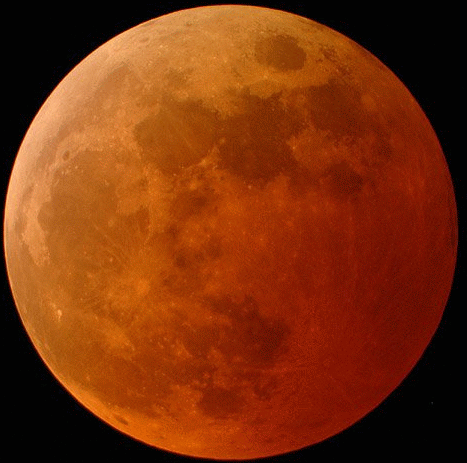I wrote about all of this before and am recycling a lot of the material from previous posts.
SuperMoon (March 12, 2011)
"Supermoon" Nonsense (May 6, 2012)
Blood Moon Bullshit (April 13, 2014)
Johannes Kepler (1571-1630) is remembered by astronomers for developing the Three Laws of Planetary Motion which showed that planets orbited the Sun in elliptical orbits, not the previously believed perfect circles. Similarly, our Moon orbits the Earth in an ellipse. This means that it is sometimes a bit closer to the Earth (perigee) and sometimes a bit further (apogee).
The ellipticity of this orbit is exaggerated
This coming Sunday, September 27, 2015, the Moon will be full (as it is every 29.53 days). It will also be 356,876 kilometers from Earth - the closest perigee approach for the entire year. Sometimes perigee corresponds to the full moon phase, sometimes not. It is however, completely predictable and understood (here's an online apogee and perigee calculator).
Is there anything special about this distance on September 27? Not really. If you want really extreme perigees, you missed the last one if you're younger than 85 years old. It occurred on January 15, 1930 when the Moon was 356,397 km from the Earth. Forget about the next extreme perigee, it will occur on January 1, 2257 when the Moon is a mere 356,371 km away.
When perigee occurs near the time of a full moon, the news media has taken to calling these events "Supermoons". "Supermoon" is a mostly bullshit term which was popularized by an astrologer (not astronomer, there is a difference!) named Richard Nolle. I say mostly bullshit because it is grounded in real astronomy (the orbit and phases of the Moon) but attributes special astrological (imaginary) qualities to a Moon that's at perigee when it's full (there's the bullshit part). All kinds of bad things are supposed to happen. They don't.
Technically, these events are called a perigee-syzygy where syzygy refers to an astronomical alignment of 3 or more celestial objects - in this case the Sun, Earth, and Moon. Perigee and apogee are not linked to the Moon's phases because of differences in their cycles. The amount of time from perigee to perigee is 27.55455 days. The amount of time from full Moon to full Moon is 29.53059 days. That's a two-day difference.
Since:
14 x 29.53059 days = 413.43 days
and
15 x 27.55455 days = 413.32 days
These cycles approximately coincide every 413 days. So, since we have a perigee full moon on September 27, 2015, we can expect a perigee full moon again 1 year and 48 days later on November 14, 2016. Guess what the Lunar Perigee and Apogee Calculator says? That's right, another perigee full moon on November 14, 2016. (science works!). That perigee will be even closer at 356,511 km!
δ = 2 tan-1 [(D/2)/d]
where D is the diameter of the Moon, d is the distance from the Earth to the Moon, and δ is the angular size of the Moon in the sky.
The mean diameter of the Moon is 3,476 km. Let's calculate the difference in this month's "super" Moon angular diameter versus that of the "average" Moon (384,403 km distant).
"Super" Moon:
δ = 2 tan-1 [(D/2)/d] = 2 tan-1 [(3,476 km/2)/356,953 km] =0.558°
"Average" Moon:
δ = 2 tan-1 [(D/2)/d] = 2 tan-1 [(3,476 km/2)/384,403 km] = 0.518°
That's a difference of 7.7% when looking at the Moon in the night sky. Here is the difference between an apogee and perigee full moon (actual images from 2006):
Noticeable in the picture, but could you tell from one month to the next? And this is NOT how large the full Moon appears in the sky. Go outside anytime the Moon is full, outstretch your arm and extend your pinkie finger. The fingernail on your pinkie finger will easily cover the Moon.
Not as big as it looks here!
Turns out there's also a total lunar eclipse Sunday evening that will be visible across the United States. Also, and this is depressingly predictable for the Hudson Valley during interesting astronomical events, the weather forecast currently says "partly cloudy" for Sunday night (seriously, it's always cloudy around here when anything of astronomical significance occurs).
This NASA site has useful information if it happens to be clear where you on Sunday evening (yes, NASA calls it a "supermoon" - don't get me started on their public outreach pandering).
One of the neat things about an eclipsed Moon is that it turns a beautiful reddish color.
Why is that? Well let's first look at what causes lunar eclipses. As shown in the diagram below (not in any way to scale), we see that an eclipse occurs when the Moon moves into the Earth's shadow - the umbra (there are penumbral eclipses, but they're too dim for most people to notice). When the Moon is in this position, on the opposite side of the Earth from the Sun, it's at its full moon phase (the side of the Moon facing us is normally fully lit by the Sun).
So, why don't we have total lunar eclipses every month when the Moon is in that position? To answer that, let's first look at the true scale of the Earth and the Moon (size and distance).
Now consider that the Moon does not orbit the Earth is the same plane as the ecliptic (the plane in which the Earth orbits the Sun). The Moon's orbit is tilted by just over 5° from the ecliptic. About half the time the Moon is below the ecliptic (and can't pass into the Earth's umbral shadow) and about half the time the Moon is above the ecliptic (and also can't pass into the Earth's umbral shadow). Only when the Moon is passing through the ecliptic (points called the ascending or descending nodes) at the same time it happens to be a full moon, can we have a total lunar eclipse (you can also have partial and penumbral eclipses if things are quite exactly lined up).
For the 100 years from 2000 through 2099, there will be 85 total lunar eclipses (and 87 penumbral and 58 partial).
OK, back to the red Moon during an eclipse. If the Earth had no atmosphere, the eclipsed Moon would be dark. But because the Earth has an atmosphere and the gases in our atmosphere (78% nitrogen and 21% oxygen) scatter the shorter wavelength light at the blue end of the color spectrum, the longer wavelength reddish light makes it through. This is why the sky looks blue on a sunny day (the blue light being scattered about) and why sunsets and sunrises look red (the longer wavelengths making it through the thick atmosphere on the horizon to our eyes). As the reddish light passes through our atmosphere, it's also refracted (bent) and this allows it to faintly illuminate the Moon during a total eclipse.
This is called science, boys and girls. Basic knowledge of eclipses goes back thousands of years to the ancient Babylonians and since then we've learned quite a bit about how it all works. Using celestial mechanics, we can predict, with virtual 100% certainty, that there will be a total lunar eclipse on September 14, 2099 at 16:57:52 UTC visible in North America (mark your calendars).
OK, now here's where I'm going to piss some people off. Crazy Texas televangelist John Hagee from Cornerstone Church in San Antonio is preaching that this month's eclipse is the fourth of a series of four "blood moon" eclipses heralding the end of the world (the ever-popular apocalypse).
So, what is a blood moon? According to CBN News (Pat Robertson's organization):
"A blood moon is when the Earth comes between the sun and the moon," Hagee explained. "And the sun is shining through the atmosphere of the Earth and casts up on the moon a red shadow. And so the moon appears to be red."
Um, OK, but that's what happens with virtually all total lunar eclipses. Now all of a sudden the dumb ass lazy journalists writing for all these media outlets are calling the eclipse a "blood moon" (just Google the phrase to see)! What the fuck? There's nothing special at all about this particular eclipse.
But wait, Steve, you might say, Hagee is arguing that this is a special sequence of four eclipses. Again, according to CBN News:
"Blood moons are set to appear in April 2014, on
Passover, and then again in September 2014 during the Feast of
Tabernacles, or Sukkot.
The timing is the same for 2015 -- a total of four blood moons, all appearing on Jewish feast days.
"The sun and the moon and the Earth are controlled
by God almighty," Hagee said. "He is the one that is getting them in a
direct alignment on a certain day at a certain time -- but each time,
it's a Passover or Sukkot."
Well, if God's controlling the Sun and Moon, he's doing it in such a way that it's completely indistinguishable from perfectly natural physical processes (e.g. gravity). Go to the NASA Eclipse page to view a 5,000 year calendar of lunar eclipses to see how perfectly predictable it all is.
Yes, there are total lunar eclipses on Passover and Sukkot in 2014 and 2015 (October 8, 2014, not September as the news article incorrectly states, but oh well). Is there something special about this? Well, think about the following. Total lunar eclipses can only occur on the full moon. The Jewish holidays of Passover and Sukkot are tied to the Jewish lunar calendar. Passover starts on the night of the full moon after the vernal equinox and Sukkot also starts on a full moon six lunar months later.
Since these Jewish holidays start on the full moon, and lunar eclipses are on a full moon, it's certainly inevitable that they should line up sometimes. Lunar eclipses also occur in cycles and tetrads (a group of 4 eclipses such as this) are not all that unusual.
As the following table from Universe Today shows, there are 8 of these tetrad eclipses in the 21st century:
| Eclipse #1 | Eclipse #2 | Eclipse #3 | Eclipse #4 |
| May 16th, 2003 | November 9th, 2003 | May 4th , 2004 | October 28th, 2004 |
| April 15th, 2014*+ | October 8th, 2014 | April 4th, 2015*+ | September 28th, 2015 |
| April 25th, 2032 | October 18th, 2032 | April 14th, 2033*+ | October 8th, 2033 |
| March 25th, 2043* | September 19th, 2043 | March 13th, 2044 | September 7th, 2044 |
| May 6th, 2050 | October 30th, 2050 | April 26th, 2051 | October 19th, 2051 |
| April 4th, 2061*+ | September 29th, 2061 | March 25th, 2062* | September 18th, 2062 |
| March 4th, 2072 | August 28th, 2072 | February 22nd, 2073 | August 17th, 2073 |
| March 15th, 2090 | September 8th, 2090 | March 5th, 2091 | August 29th, 2091 |
| *Paschal Full Moon | |||
| +Eclipse coincides with Passover | |||
No big deal. If anyone's convinced that the end of the world is nigh because of these lunar eclipses, I'd be happy to take any extra money off your hand - won't need it after you're raptured anyway, right? The world will end because of human stupidity and greed, not because of a capricious god.
So that's why your humble science professor does not like the terms "supermoon" and "blood moon" even though they're all over news stories of the coming eclipse. These words are grounded in pseudoscientific astrological and religious nonsense and give the impression that these completely natural and predictable astronomical events have special significance for humans. They don't. Go out and bask in the beauty of this celestial show. I will. Just remember that this event was predicted by scientists, not astrologers or televangelists.











